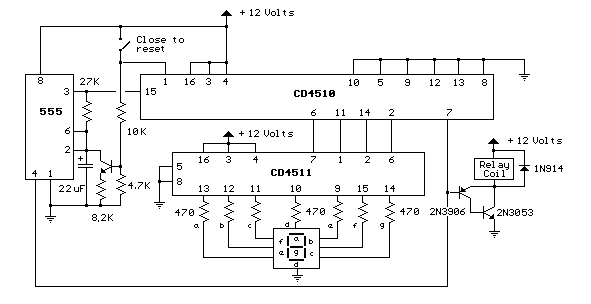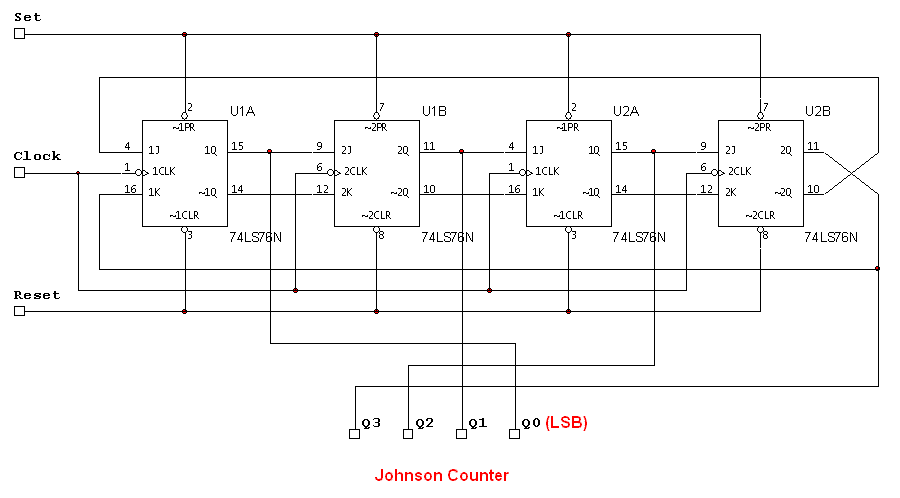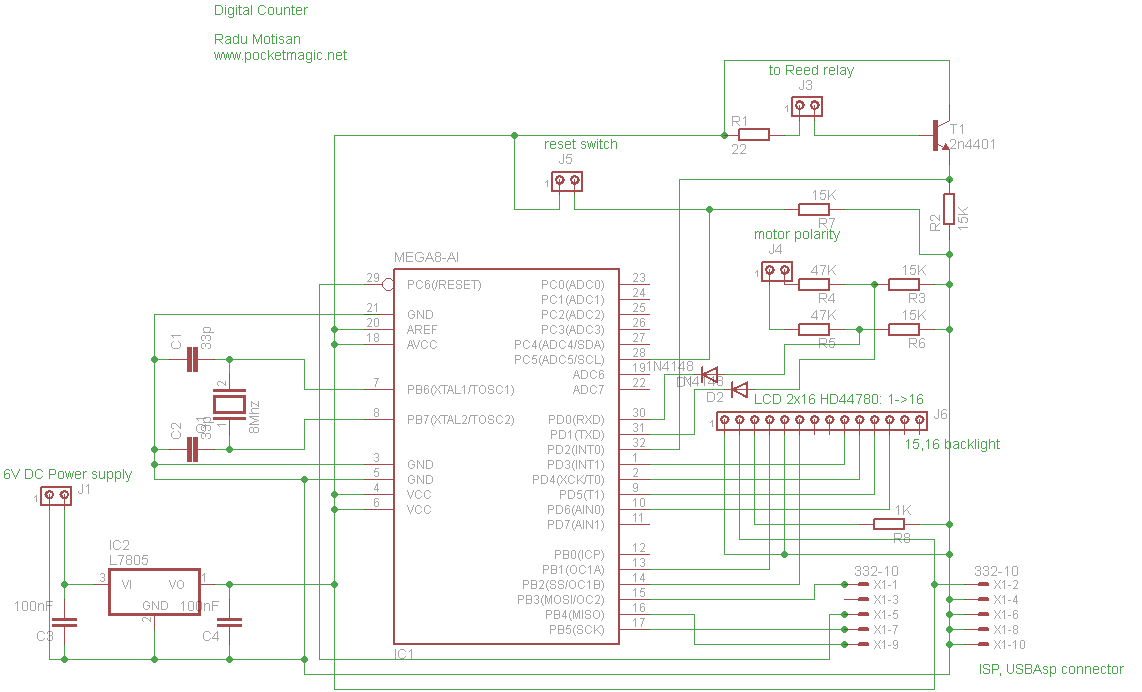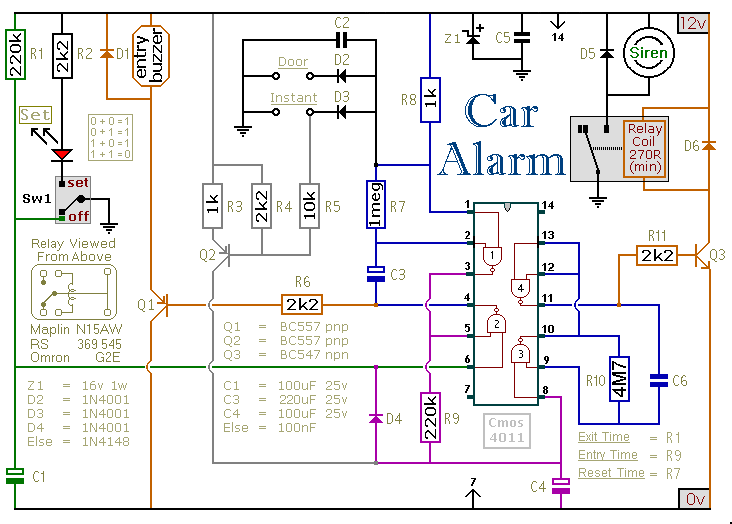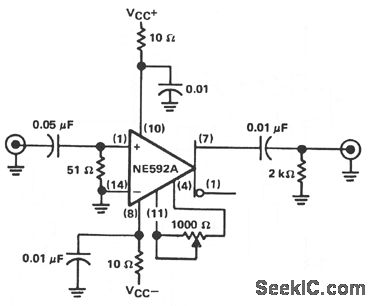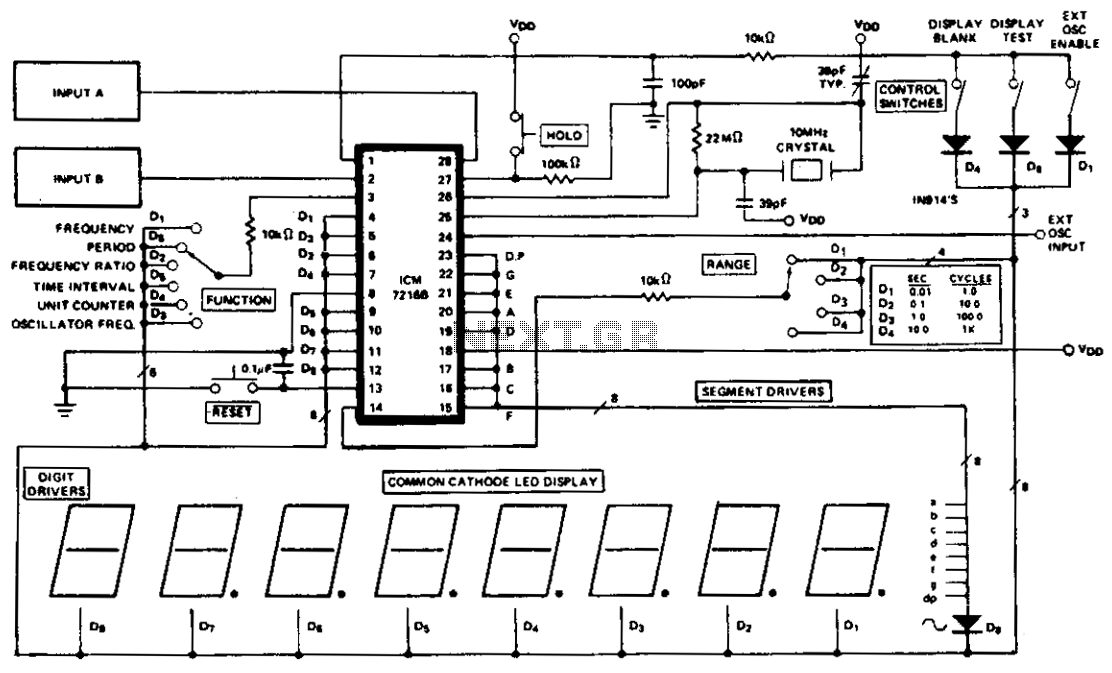
build your own geiger counter
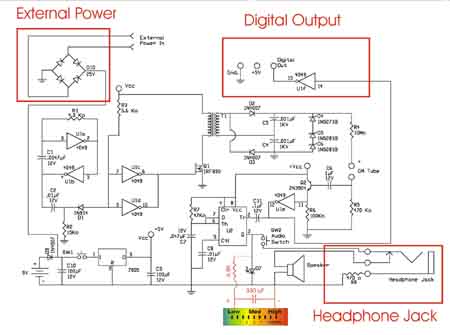
The basic Geiger counter circuit is similar to the previous version, with the addition of components for three optional enhancements: an external power input, a headphone jack, and a digital output, highlighted in red. The external power input is designed to accommodate a variety of wall transformers that can supply a minimum of 75 mA with voltages ranging from 7-12 VAC or 7-12 VDC. A bridge rectifier rated at 25V and 1 amp is included, and any bridge rectifier with comparable or superior specifications can be utilized in the circuit. The positive output lead of the bridge rectifier is positioned after the D9 diode, which serves to protect the battery when external power is utilized. The headphone jack, while primarily intended for headphones, can also serve as a temporary output for an analog meter. This 3.5mm 2-conductor jack is equipped with a SPST switch that automatically disconnects the speaker when a headphone or analog meter is connected. The digital output jack generates a +5V TTL logic pulse each time a radioactive particle is detected, utilizing an unused gate from the 4049 IC as depicted in the schematic. An interface will be constructed between this output and a Windows PC, enabling the use of free Geiger counter graphing software.
The circuit design for the enhanced Geiger counter incorporates several key components that work together to improve functionality and usability. The external power input allows for flexibility in power sources, enabling users to connect various wall transformers that meet the specified voltage and current requirements. The inclusion of the bridge rectifier converts the AC voltage from the transformer into DC voltage, which is essential for the operation of the Geiger counter. The D9 diode plays a critical role in safeguarding the internal battery from potential backflow of current when the external power is engaged, ensuring the longevity and reliability of the device.
The headphone jack serves dual purposes, allowing for audio output when headphones are connected and providing an interface for an analog meter when needed. The SPST switch integrated into the headphone jack simplifies the user experience by automatically managing the connection state, eliminating the need for manual disconnection of the speaker.
The digital output feature is a significant enhancement, providing a TTL logic pulse that can be easily interfaced with a computer. This allows for real-time data logging and visualization of radiation levels using compatible software. The unused gate from the 4049 IC is employed to generate this output signal, showcasing the versatility of the integrated circuit in expanding the functionality of the Geiger counter. Overall, these enhancements make the Geiger counter a more versatile and user-friendly instrument, suitable for various applications in radiation detection and analysis.The basic Geiger counter circuit is identical to the previous circuit. The revision is the adding of the components for our three optional enhancements; external power input, headphone jack and digital output, boxed in red. External Power – The external power is designed to allow a wide range of wall transformer to power the Geiger counter.
Wall transformers that can supply a minimum of 75 mA with voltages that range from 7-12VAC or 7-12VDC will work. The bridge rectifier is rated at 25V 1 amp. Pretty much any bridge rectifier with specifications around these specifications (or better) will work when placed inside the circuit. The positive output lead of the bridge rectifier is placed after the D9 diode. The D9 diode protects the battery when using external power. Headphone Jack – Aside of its obvious use for a headphone, this jack may also be used as a temporary output for an Analog Meter.
The headphone jack is a 3. 5mm 2-conductor jack with a SPST switch. The switch automatically disconnects the speaker when the headphone or analog meter is plugged in. Digital Output – The digital output jack provides a +5V TTL logic pulse every time a radioactive particle is detected. The digital output uses an unused gate off the 4049 as shown in the schematic. We will build a small interface between this output and a Windows PC. This will allow you to use one of the free Geiger counter graphing programs. 🔗 External reference
The circuit design for the enhanced Geiger counter incorporates several key components that work together to improve functionality and usability. The external power input allows for flexibility in power sources, enabling users to connect various wall transformers that meet the specified voltage and current requirements. The inclusion of the bridge rectifier converts the AC voltage from the transformer into DC voltage, which is essential for the operation of the Geiger counter. The D9 diode plays a critical role in safeguarding the internal battery from potential backflow of current when the external power is engaged, ensuring the longevity and reliability of the device.
The headphone jack serves dual purposes, allowing for audio output when headphones are connected and providing an interface for an analog meter when needed. The SPST switch integrated into the headphone jack simplifies the user experience by automatically managing the connection state, eliminating the need for manual disconnection of the speaker.
The digital output feature is a significant enhancement, providing a TTL logic pulse that can be easily interfaced with a computer. This allows for real-time data logging and visualization of radiation levels using compatible software. The unused gate from the 4049 IC is employed to generate this output signal, showcasing the versatility of the integrated circuit in expanding the functionality of the Geiger counter. Overall, these enhancements make the Geiger counter a more versatile and user-friendly instrument, suitable for various applications in radiation detection and analysis.The basic Geiger counter circuit is identical to the previous circuit. The revision is the adding of the components for our three optional enhancements; external power input, headphone jack and digital output, boxed in red. External Power – The external power is designed to allow a wide range of wall transformer to power the Geiger counter.
Wall transformers that can supply a minimum of 75 mA with voltages that range from 7-12VAC or 7-12VDC will work. The bridge rectifier is rated at 25V 1 amp. Pretty much any bridge rectifier with specifications around these specifications (or better) will work when placed inside the circuit. The positive output lead of the bridge rectifier is placed after the D9 diode. The D9 diode protects the battery when using external power. Headphone Jack – Aside of its obvious use for a headphone, this jack may also be used as a temporary output for an Analog Meter.
The headphone jack is a 3. 5mm 2-conductor jack with a SPST switch. The switch automatically disconnects the speaker when the headphone or analog meter is plugged in. Digital Output – The digital output jack provides a +5V TTL logic pulse every time a radioactive particle is detected. The digital output uses an unused gate off the 4049 as shown in the schematic. We will build a small interface between this output and a Windows PC. This will allow you to use one of the free Geiger counter graphing programs. 🔗 External reference
